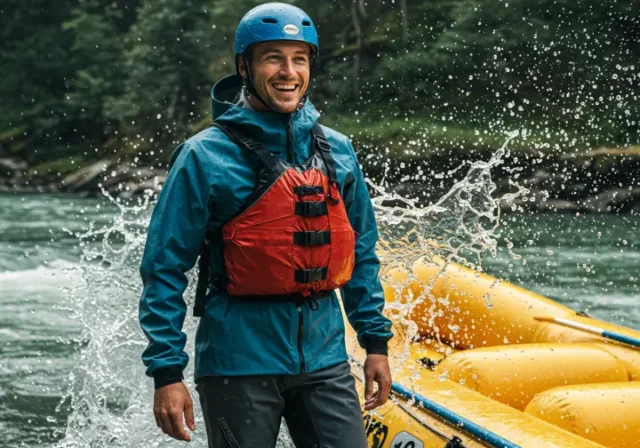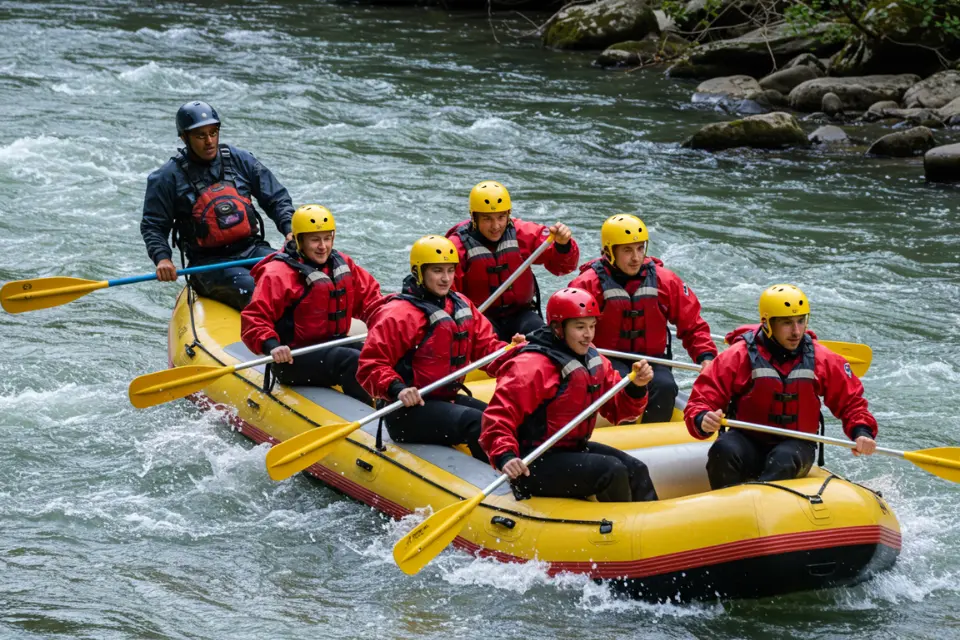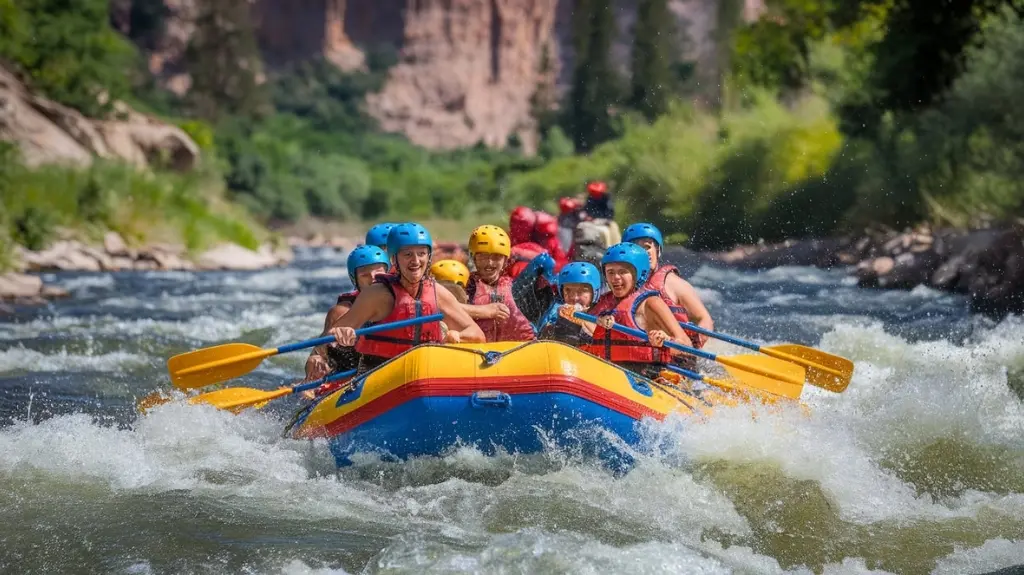In this article
For whitewater rafting, layering is key. You’ll want a moisture-wicking base layer, an insulating mid-layer, and a waterproof outer shell. Wetsuits or splash jackets can provide additional warmth in cooler conditions. Choose quick-drying fabrics such as synthetics or merino wool, and avoid cotton. Water shoes or river sandals with good grip are essential. Don’t forget sun protection: hats, sunglasses, and sunscreen. Pack extra clothes in a dry bag, and never wear loose jewelry. For more in-depth information on river attire, continue reading.
Riding the Rapids in Style and Comfort
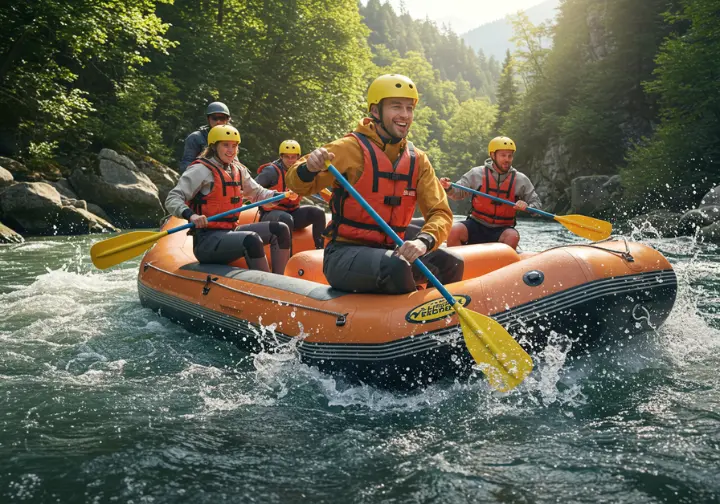
Forget just looking good – understanding what to wear white water rafting is essential for staying safe, comfortable, and fully immersed in the thrill of the ride. When planning what to wear rafting, recall layering is key.
Think of your rafting gear as your armor against the elements. You’ll want a base layer like a swimsuit that won’t bog you down. Always avoid cotton clothing since It’ll soak up water and leave you shivering. Remember, garments should also have a snug fit to prevent snagging.
Water shoes are a must for grip and foot protection. On cooler days, a wetsuit or splash jacket can be a revelation, providing essential insulation.
And waterproof gear? Non-negotiable. After all, whitewater rafting is all about getting wet!
Essential Clothing for Whitewater Rafting
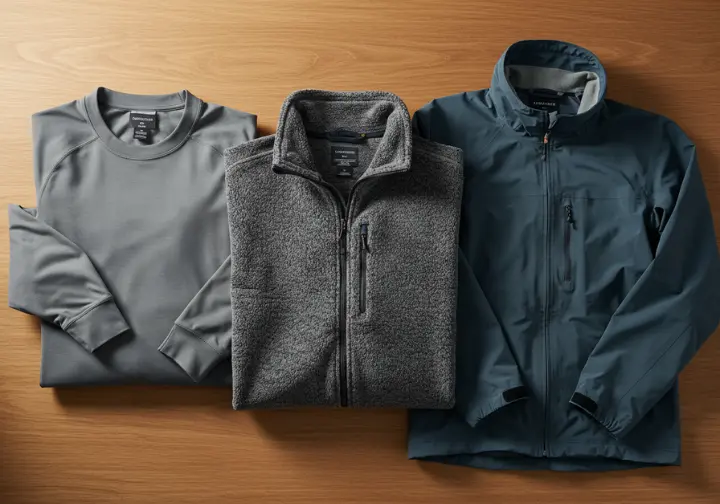
You’ll need to know how to layer properly for whitewater; it’s key for staying comfortable.
Think about your base layers that wick moisture, mid-layers for warmth, and outer layers which shield you from wind and water. Knowing this will make sure your comfort is covered.
We should examine these critical layers so you’re prepared for anything the river throws your way.
Base Layers: The Foundation of Comfort
Since a base layer is the foundation of comfort, it’s your first defense against the elements during any rafting trip. You’ll find that wearing the right clothing makes it worthwhile. Base layers work by wicking moisture, keeping you dry.
Choose non-cotton clothing made of synthetic materials guarantees comfort. Nylon, polyester, quick-drying layer, and wool are good options since they pull moisture away from your body. A polyester/elastane blend is also ideal as it offers stretch and mobility.
Cotton absorbs moisture and stays wet. So it’s best to avoid cotton.
Base layers can keep you comfortable through the entire rafting trip! You’re sure to value dry clothing and materials made of wool and nylon.
Mid Layers: Insulation for Warmth
As vital as your base layer is, you’ll need a mid-layer to maintain warmth on the river; it’s your insulation against the chill when the water’s cold or the weather turns.
Think of mid-layers as the unsung heroes of your rafting trip, working tirelessly to regulate your body temperature.
Fleece jackets are popular for good reason. They provide excellent warmth and breathability, even when you’re dealing with wet clothes or unexpected splashes of cold water. Synthetic sweaters are another solid choice, offering similar insulation. You can consider an additional layer of your trusted base layers for extra warmth if you’re rafting in particularly chilly conditions. The warmer months in Tennessee are ideal for this outdoor river adventure, so plan accordingly with your layering.
Ensure your mid-layer provides warmth without restricting your movement. Balance is key; you don’t want to overheat simultaneously staying comfortable on the water. Retain this unlike a windbreaker, the focus of the mid layer is warmth.
Outer Layers: Protection from the Elements
After ensuring your body’s core stays warm with appropriate mid-layers, let’s discuss maintaining comfort and safety when the weather turns. This is where your outer layers come in. Fundamentally, they’re your shield against wind, rain, and sun. You’ll want to contemplate these:
- A waterproof jacket is a must.
- Splash pants are a great call for extra protection.
- Don’t skimp on sun protection.
- Pack a dry bag with extra clothes!
We all know how quickly things can change on the river. Windproof jackets and waterproof options keep you dry and comfortable, as splash pants add an extra layer of defense. Consider shorts made of quick-drying synthetic fabrics for optimal comfort and performance.
Bear in mind sun protection is more effective with appropriate clothing.
Keep your gear and extra clothes dry! You’ll thank me later. Gear up, stay safe, and respect the river.
Seasonal Adaptations for Rafting Attire
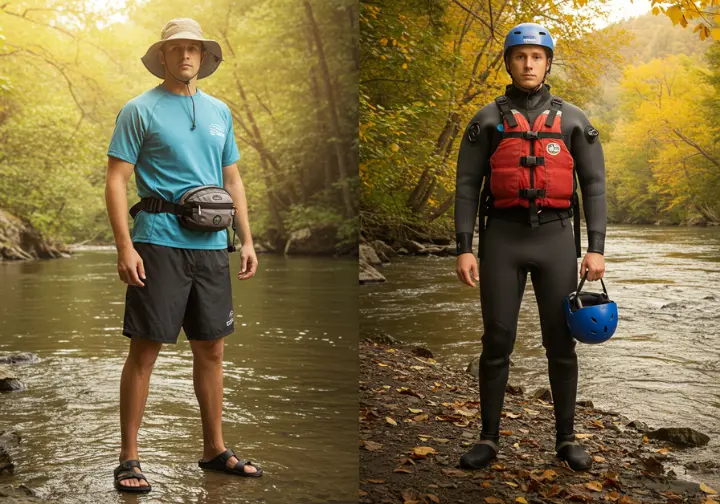
You’ll need different gear depending on the season! We’re going to cover what you should wear for summer sun and splashes, then move into battling cold water in the spring and fall. Additionally, it’s important to note that wetsuits are provided during the month of March due to mild water temperatures. Finally, we’ll make sure you stay warm in extreme conditions for winter rafting.
Summer Rafting: Sun and Splash Protection
Summer’s radiant challenge on the river demands respect. Sun protection’s key, so lather on this sunscreen and reapply often since those rays reflect like crazy.
You’ll want to wear quick-drying water shorts or swim trunks, and an athletic shorts. Don’t forget your sunglasses + paddling hat! Wear a water shirt to shield your skin. Avoid cotton. Essential to your eye health, ensure your lenses provide 100% UV protection.
Here’s how to gear up smartly:
- Choose a quick dry bathing suit or swim trunks this dry in a snap.
- Don’t forget UV protection! It’s ideal for long days.
- Polarized sunglasses protect your eyes.
- Paddling hat, to provide much needed sun protection.
Spring/Fall Rafting: Combating Cold Water
As conditions cool, every seasoned rafter knows how battling the chill in spring and fall means adapting your gear to defy the cold water‘s bite, so let’s delve into how to stay warm and safe when the temperatures drop. You’re facing cold water, so forget air temperatures and focus on the water temperature instead.
Wetsuits give fantastic insulation, trapping a layer that warms against your skin. Neoprene booties become crucial for safeguarding your feet, and choosing snug fits keeps cold water out. Neoprene gloves also help to maintain finger warmth and dexterity. Splash jackets constructed from nylon materials or similar offer protection from the elements. A waterproof jacket amps up your defense. Don’t forget dry clothes waiting post-rafting! Invest in wetsuit boots for enhanced grip. The wetsuit material is your main defense. Bear in mind, staying warm means safety.
Winter Rafting: Staying Warm in Extreme Conditions
When Old Man Winter grips the river, you’re not just battling cold; you’re facing an entirely different beast which demands respect and the right gear.
Layering’s your mantra. You’ll need a thermal base, think merino wool, to wick away moisture; vital when those rapids splash. Don’t skimp – wool socks are non-negotiable. You might consider a wet suit, especially if you’re spending extended time in the water. A drysuit with booties will enhance comfort and warmth in frigid waters.
Here are four must-haves to combat the winds:
- Thermal base layers.
- Waterproof outerwear.
- Wool Socks.
- Warm Hat.
Remember, cotton’s your enemy.
Your flotation device (PFD) straps should fit snugly over your clothes. Pack a towel in a waterproof bag. The river demands respect, and staying warm guarantees you can answer its call safely. Enjoy the stark beauty.
Footwear: Grip, Protection, and Comfort
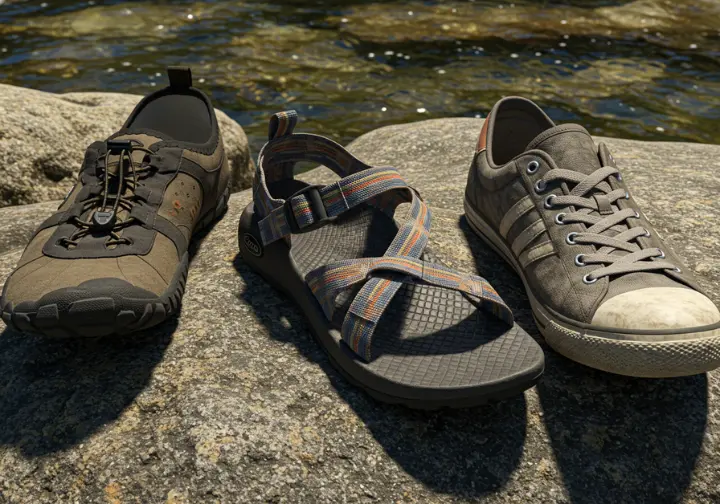
You’ll want the right footwear; trust us, it makes a massive difference as you’re keeping your team safe and paddling hard!
We’re going to explore how choosing the right shoes impacts your grip and protection and how the socks you pick influence insulation and comfort. For cold water rafting, specialized boots often offer insulation. Let’s figure out how to keep your feet happy on the river that time!
Choosing the Right Shoes
Your dogs are essential for traversing river terrain. You’ve gotta choose water shoes wisely when facing slick riverbeds.
Sturdy water shoes offer protection—think aquasocks, wetsuit booties or even old tennis shoes.
River sandals with straps (Tevas, Chacos) work great, guarantee a snug fit. You don’t want them flying off if things get wet!
Avoid flip-flops—they’re more of a hazard than help. Guarantee every sandal has a retention strap—one slip can ruin your day.
Keep these in mind:
- Grip: Critical for stability.
- Protection: Shield your feet.
- Comfort: Happy feet, happy rafting.
- Security: Keep ’em on!
Socks: Insulation and Comfort
Often overlooked yet indispensable, socks stand as a cornerstone of your rafting footwear setup, delivering insulation, comfort, and protection for your feet, so you’re able to stay warm and dodge blisters and chafing. If it’s battling cold water passing through your raft or a sunny day, socks are essential, since you can’t have fun if you have feet issues.
For cold water temps, wool or neoprene socks offer great insulation. Wool, like Smartwool socks, retains warmth even when wet. Neoprene socks trap water, which your body heats.
Even in warmer conditions, wear socks to prevent chafing and blisters. River water can be surprisingly tough on your bare feet all day.
Choose socks considering thickness and fit. Thicker socks offer more insulation but can tighten your shoes. Guarantee your socks fit snugly to prevent bunching. Prioritize the health of your precious feet, and your feet will protect you from blisters and the cold.
Essential Accessories for a Successful Trip

You’re facing sun, rocks, and the unexpected, so consider every necessity. Don’t underestimate your accessories, cause they’ll make or break your trip!
We’ll examine sun protection, safety gear, hydration, and smart storage, so you’re dialed in.
Sun Protection: Shielding Your Skin
The river’s glare can be deceptive, turning a glorious day into a painful lesson if you’re not prepared. Protecting yourself from the sun is vital for a comfortable and safe river trip.
You’re dealing with intense reflection from the water, so sunscreen is your best friend. Use a high SPF and reapply often, especially after swimming or any watersports.
Sun hats are fundamental to keep the sun off your neck. Sunglasses with a strap guarantee you don’t lose them in the rapids, if you’re bathing or not. Don’t forget these hot spots:
- Ears
- Lips using balms.
- Back of your neck
- The tops of your feet
Even if you’re wearing a swimming suit, exposed skin needs protection. Stay hydrated, and don’t forget your water bottles; it’s easy to underestimate the sun when you’re having fun.
Safety Gear: PFDs and Helmets
Given the inherent risks of whitewater rafting, safety gear isn’t just recommended; it’s critical to reduce injury from accidents, making Personal Flotation Devices (PFDs) and helmets the two most important items you’ll need, so choose them carefully and use them properly.
Your personal flotation device is vital: it floats you.
You’ll need a US Coast Guard-approved PFD with proper flotation. It’s your best friend if you fall out, keeping you afloat like a tube.
You’ll as well need a helmet, vital for protection from hazards. A paddling helmet protects you from impacts. It should fit snugly.
Whether you’re using a paddle to navigate, or you’re just one of the rafters on the boat, the helmet is vital. These two items are non-negotiable, so don’t compromise on quality. Don’t forget to buy an approved waterproof case if you want to keep any of your electronics dry.
Hydration and Storage: Staying Prepared
Rivers demand respect, and a key part of this respect is staying prepared: we’ve got to hydrate and keep our necessities secure.
On river trips, dehydration’s your enemy; bring water bottles to stay ahead. You’ll see varying water levels, so protect your requirements! Consider these must-haves:
- 1. Hydration: Water bottles or hydration packs are vital.
- 2. Dry Bags: Invest in water-resistant and waterproof case options for electronics.
- 3. Secure Pockets: Zippered pockets on your clothing keep small items secure.
- 4. Requirements: Sunscreen, lip balm, and any necessary medications.
Using zippered pockets will allow you to secure keys and credit cards and prevent that sinking feeling when gear goes overboard.
Dry bags guard against splashes, ensuring cameras and phones survive. With those protections, you’re set for awesome and worry-free river trips!
What NOT to Wear: Avoiding Common Mistakes
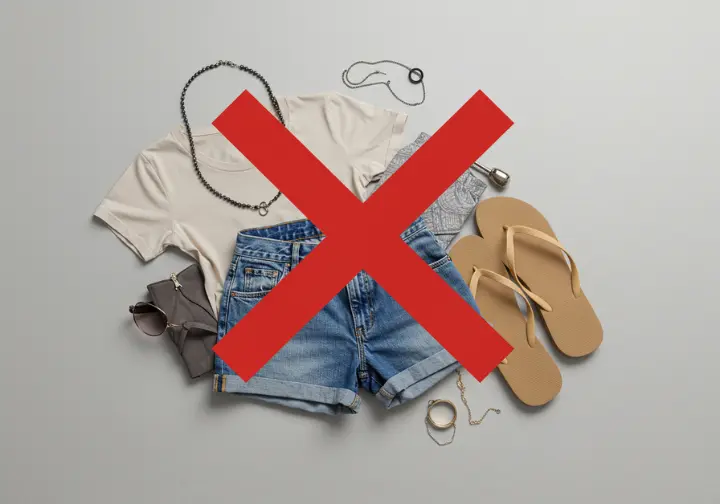
You’ve got your rafting gear ready, but hold on–are you sure you’re fully prepared? We need to chat about what stays ashore, since some clothing and accessories can really ruin your trip, or even become a safety hazard.
Let’s make sure you avoid these common mistakes!
Cotton Clothing: A Rafting Faux Pas
Even though it might seem innocent enough, cotton clothing is a major rafting faux pas which can quickly turn a thrilling river adventure into a chilly ordeal. When you consider what to wear white water rafting, think beyond comfort. This comfy cotton t-shirt? Leave it at home! It acts like a sponge, absorbing water and refusing to let go.
So, what do you wear rafting instead? Focus on quick-drying fabrics like synthetics or merino wool.
Picture paddling hard; you’re likely to swim or get splashed. Cotton bottoms or shirts will only weigh you down, especially in cooler water temperatures. We want dry bottoms, not shivers! A day on the raft shouldn’t lead to hypothermia.
Why avoid cotton? Here’s the rundown:
- Absorbs water easily
- Dries incredibly slow
- Draws heat away from your body
- Increases your risk of chills
Choose your whitewater rafting clothes carefully, and you’ll have a much more enjoyable time out on the water.
Loose Jewelry: Securing Valuables
Since rivers and rapids are ever-changing, every item you bring on a whitewater rafting trip faces the risk of being swept away, including that sentimental ring or your favorite pair of earrings. Jewelry isn’t just a fashion statement; it’s a potential hazard. You don’t wanna lose something precious during personal rafting trips or even on commercial rafting trips, do you? We, as river drifters, know about these issues!
Consider leaving prized possessions behind. If you must wear a watch, guarantee it’s waterproof and has a secure strap—one that won’t fail. Waterproof suits, waterproof shell, waterproof pants, and wearing a swimsuit is a great place to start with swim shorts, but they don’t help with jewelry. That floatation device you will be wearing is only for surviving the waters. You’ve been warned.
Unsuitable Footwear: Prioritizing Safety
Footwear can make or break your rafting adventure, so you’ll want to think twice about what’s on your feet. Forgetting proper footwear when considering what clothes to wear for river rafting isn’t an option. It’s about safety.
We don’t want you sliding around or hurting your feet on those rocky riverbeds. You’ll need grip and protection regardless if you’re on an easy float in the shallows or tackling whitewater. Footwear is imperative to your floatation. So steer clear of these:
- Flip-flops: Useless, offering no protection. These aren’t appropriate for what to wear rafting in summer.
- Athletic shoes: They’ll get waterlogged and heavy.
- Anything without a secure strap: Wave farewell as they float downstream.
- Anything without a sole: These won’t cut it when walking among the river drifters.
Grab those secure water shoes. These are useful with paddle gloves and splash jacket.
Gear Up and Raft On!
Now since you’ve reviewed all the indispensable items, it’s time to assemble your rafting gear for an incredible trip on the river.
If you’re hitting splashy rapids on whitewater adventures, a paddle jacket or even a dry suit is often paramount, especially for professional whitewater or an overnight river trip. Think about paddling-specific tops made of coated nylon that’ll deflect water and block mild winds.
We’re talking comfort and safety, so check the weather and water temperature beforehand! Don’t forget to confirm gear availability with your outfitter. Bear in mind, following high-quality river practices and wearing the right gear lets you enjoy every moment. Now, book this rafting adventure and get ready for the time of your life.
Popular Questions
Is There a Weight Limit for Whitewater Rafting?
What Happens if I Lose My Sunglasses in the River?
Are Life Jackets Provided, or Do I Need to Bring One?
Can I Bring My Phone or Camera on the Raft?
How Physically Fit Do I Need to Be for Rafting?
We are a participant in the Amazon Services LLC Associates Program, an affiliate advertising program designed to provide a means for sites to earn advertising fees by advertising and linking to Amazon.com. As an Amazon Associate I earn from qualifying purchases. We also participate in other affiliate programs. The information provided on this website is provided for entertainment purposes only. We make no representations or warranties of any kind, expressed or implied, about the completeness, accuracy, adequacy, legality, usefulness, reliability, suitability, or availability of the information, or about anything else. Any reliance you place on the information is therefore strictly at your own risk. Additional terms are found in the terms of service.


